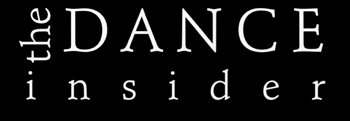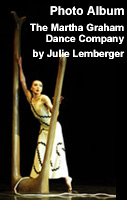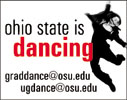











|
Flash Review 1, 10-23:
From Paris, Avec Feeling By Paul Ben-Itzak PARIS -- For about seven years, or as long as I've been covering dance intensely, I've been hearing what a brilliant dude this guy Balanchine was. So much so that he doesn't even require a first name on first reference -- kinda like, well, "God." So I've not really broadcast the fact that, er, many of his ballets leave me cold. But I had a nagging sense -- mostly from seeing the work performed by Dance Theatre of Harlem and Suzanne Farrell's companies -- that it didn't need to be so. Well, Saturday night at the Palais Garnier, courtesy of Paris Opera Ballet dancers Jean-Guillaume Bart, Agnes Letestu, Delphine Moussin, Karin Averty, Beatrice Martel, Aurore Cordellier, and Dorothee Gilbert, I was re-educated: It definitely ain't necessarily so. Balanchine does not have to be coldly rendered. The abstract, architectural beauty of his ballets can be given, well, life, in a way that, er, gives it life! Elsewhere on Saturday's mostly winning mixed program, Manuel Legris provided a reminder of how Jerome Robbins humanized the dance, Marie-Agnes Gillot and Clairemarie Osta rendered Angelin Preljocaj's stark world with warm humanity, and dancers no less talented than all these could not save the evening's one premiere, Lionel Hoche's "Yamm," from making me want to yell, "J'accuse!" (As I don't know how to say, "Make it stop!" or "Oy!" in French.) The French staging (no Balanchine repetiteur is credited in the program) of the 1928 "Apollon Musagate" catches you by the solar plexus pretty much from the moment Beatrice Martel, as Apollo's mother giving birth to the oracle god in this rarely given full version, catches the light from atop a riser of stairs upstage. (A refresher is perhaps in order here: The Garnier stage is raked, so when we talk upstage and downstage, we're using the terms literally, and the effect of this precipitation is usually stunning for one not used to it.) Martel's legs go up, they spread open, her stomach contracts. Apollo (Bart, substituting for Nicholas Le Riche Saturday) materializes, fully swathed, and then Cordellier and Gilbert remind us there are no small parts, only small actors, when they delicately, excitedly unfurl the cloth and release a fumbling, tentative Bart. From a technique standpoint, Bart might be called, relatively speaking, the weak link here in a cast of killer women (in both their amplitude of heart and aptidude of body). And yet his lack of technical virtuosity actually works to his advantage here. His is the first Apollo I've seen, with the possible exception of Ethan Stiefel, who really is tentative, not just in the first moment of unswathing but in a wonderfully measured way throughout the ballet. (Okay, I'll name names: Missing the mark in this regard were the Apollos of Igor Zelensky and Julio Bocca.) We're talking beyond the cliche here, folks. He is discovering the world, from the moment he first peels his eyes open and stumbles out of the swathing cloth, on to the higher discoveries introduced to him by Terpsichore (Letestu), Calliope (Moussin) and Polymnie (Averty). Where most Apollos I've seen only act like newborns in the prologue and then are suddenly masterful gods, Bart plays his part throughout as a young god being introduced to the world of the arts and his body's relation to them -- it's the best-acted Apollo I've seen, by far. In other casts I've seen of this ballet, the standard for the women seems to be, well, Maria Kowroski, circa 2000: High legs, pristine but ultimately sterile beauty; God forbid you should crack a smile. But the standard among these ballerinas seems to be City Ballet's Wendy Whelan, sans any of Whelan's occasional brittleness. They are digging the music (the Whelan resemblance in Letestu even extending to the way both seem to be lip-synching the music), digging each other, and it's infectious to both the male lead and to the audience. Heretofore I'd thought that Balanchine was leaving it to me to fill in the emotional substance; but no more. They all these three definitely have the technique; Kodak moments such as when all their feet go up as they lean on Apollo's back are as picture-perfect as in any other cast I've seen. We're not talking about personal warmth as a substitution for technical peak; in this company, we get both!! Moussin's Caliope seems to be truly suffering, poet-like, to produce her words; the raising of her hand to her mouth, and the mouth's nightingale-like opening, come directly from her gut, contracting in pain, right to the end. Moussin is the first ballerina I've seen who truly seems to understand the meaning of what it means to be a Poet -- that the muse often comes from and with great suffering -- and who is doing more than indicating. In the immediate situation, this is good news. But overall -- egad! It's very bad news -- that is, that every other cast I've seen, and we're talking stars at New York City Ballet, the Maryinsky/Kirov, and American Ballet Theatre -- has given such a facile, surface interpretation to these roles. As if to prove, with a negative example, that there are no small roles but their are certainly small actors. Balanchine called Apollo "the turning point in my life." And I can't help thinking that if the dancers of the company he co-founded, NYCB, are missing such a resonating aspect as the warmth so obviously inherent in Apollo -- it IS about the muses, after all! -- are they missing it in some of his other abstract ballets as well? For some of you, I know, the architecture is enough; but for non-initiates like me, the ballet needs, and can have, so much more -- and if its 20th century god, Balanchine, could be infused with such life, think of the possibilities, in terms of exponentially increasing the audience! But back to this Paris Opera cast: Averty's Polymnie is similarly natural; her final explosive utterance surprises even her, as this muse who represents the theater slinks embarassedly off. But nowhere is the capacity for danciing, well, freely, such precise choreography more evident than in Letestu's Terpsichore, virtuosic of body and heart. I never saw Suzanne Farrell, Balanchine's last great muse, dance live; but in films what impressed me most is that even in this very specific choreography, her dancing appears natural, organic, full of the joy de esprit that said she was discovering thiis dance in the moment -- rather than dancing petrified to make sure she executed every well-plotted step correctly, as Kowroski and so many other of Farrell's descendents do these days. Letestu is, perhaps, the first dancer I have seen, in Balanchine choreography anyway, who gives the choreography so naturally and free and warm. She takes choreography that is perhaps more mapped out and known in our time than any other-- to the dancers as well as to the balletomatnes who have seen it so often -- and makes it seem as if it is coming from a reaction in the moment, in her. Always eyeing Apollo -- even when her torso and head are bent way back -- it is clear that she is the one that is more than just a muse to him, and not just because she's got the pas de deux and the most steps! That warmth extends to the audience as well and, I think, accounts for much that is organic and raw in Bart's performance. Stand-out moments for him -- and again, this is the first time I've noticed these -- are, well, most of all when, towards the end, right before he rests his head in the muses' palms, he looks out and up into the world, somewhere up in the balcony, which he knows will be wondrous -- because of the way these extrtaordinary in heart and body women have foretold its aesthetic pleasures. Such warmth is evident, too, in Preljocaj's 1995 "Annonciation," which entered the POB rep. in 1996 and was reprised Saturday by Clairemarie Osta, as Marie, and Marie-Agnes Gillot, as L'Ange, which I think means...the Angel! Agnes of God, indeed! I don't think any of us can hope to fully understand what's goiing on in the mind of Preljocaj -- he strikes me as Dance's Albert Camus. And I think, also, that to communicate his work requires dancers who are deep, and at least have some inkling of not just where he's coming from, but why he's coming from there. I may be in the minority on this, but Preljocaj's "Romeo & Juliet" didn't quite work for me. I saw its integrity; I sort of saw what it was trying to do; but the pas de deux just made me think, It's so French! As played, it was more of an argument than a love duet, lots of wrestling and grappling. With "Annonciation," which I first saw at the Joyce Theater on Preljocaj's own company, I didn't have this reaction. The deficit was rather in me -- I knew I couldn't begin to understand, on first viewing, what this piece was about. But after a second viewing, in the grand frame of the Garnier, I begin to have an inkling. Story-wise, we're talking your basic initiation here; of one woman who is, in some fashion, Virginal; by another who, angel-like, out of a storm of static and interference (interfering with the bucolic Vivaldi that begins the piece) materializes, arms cast up. The small cast is deceptive, because the scale here is rather epic, and epochoal; it makes me wonder what Preljocaj might do with Joan of Arc -- HINT HINT. Here, the vocabulary is again extreme and angst-filled, but the purpose of each image is clear; as with one repeated gesture, where the Angel dips her head and curves her two arms, hawk-like, as if swooping down on a prey; then dips one arm and flutters the hand on a horizontal plane -- the hawk is suddenly a little birdy or, perhaps, a bat. This flight theme is repeated towards the end, vividly -- after a sort of purgatory interim where Osta lies sideways, prostate, sleeping really, while Gillot prepares above her. Osta rises onto the bench, and there's another flight moment -- she echoes Gillot's earlier gesture with the fluttering hands -- before Gillot moves center stage, and alights again, but not before Osta has reached an arm out, yearningly. The choreography is designed to illuminate the relationship between these two women, and how they transform each other, but it's not the choreography alone that carries it off.These woman know when to be strong and when to be vulnerable, and they do it all against a soundscore (Stephane Roy, er, counter-punching an extract from Vivaldi's Magnificat - RV 610) that can't be an easy one in which to find the musical through-line. Speaking of finding the music, in Jerome Robbins's 1994 "A Suite of Dances," the solo dancer finds it immediately, right in front of him; the solitary musician, a cellist, is right on stage. This dance was created for a late forty-something Mikhail Baryshnikov. I'd previously seen it danced by one of my favorites, City Ballet's Damien Woetzel. I thought I liked Woestzel's performance -- debonair and adult. The musician on stage thing seemed just a clever, not too orginal device; a typical slight but not too revolutionary late-Robbins tweaking. And yet on Manuel Legris, who danced it Saturday, what was a pleasant diversion -- a middle-act filler, if you please -- suddenly took on moment and even monument. A few minutes into this dance, to various Bach music for single cello, I realized: this is heavy. It's a man, not middle-aged, but late-aged for a dancer (in other words, thirty-something like moi!), savoring for perhaps the last time his ability to move fully to this music -- and maybe savoring much more, past experiences of life he'll never experience again, in quite this way. Legris, dancing opposite, really, cellist Martine Bailly, subtly, oh so subtly, uses the interplay with the musician to complement this theme: twice, it is she, not he, who wipes the sweat off her brow; the second time, having already headed upstage center, he shoots back a quick look toward her, as if catching her in the act. I was reminded very much of Mark Haim's "Goldberg Variations." What is it about Bach that lends itself to the sweet-sad experience of converging on middle-aged, or at least late-young age, men? From Legris, we get a moment, late on, where he concludes a section by -- much like Bart's Apollo, actually -- looking upward, towards and beyond his extended hand, towards that memory of something that won't be experienced anon. Then, for the finale, as if he is saying, "Enough of gloom and doom, I am here now, I am still dancing full, I'll appreciate this moment for what it is, c'est la vie" he breaks into full-out jumping, leaping, touring, and, ultimately, rapid turning. What has been a not particularly challenging dance, physically (or maybe Legris just made it look that way!) suddenly gives him a score of quick one-legged turns, which he executes with panache, confidence, and a minimum of sweat, before sliding triumphantly towards Bailly, sitting and reclining back on his hands, and smiling at her as if to say "Voila!," as the lights dim. Now then: I wish I could end this review right there, but since Lionel Hoche's "Yamm" was the one premiere on the program, and since Hoche's work is reportedly coming to an NYC venue next spring as part of the "France Moves" festival, I suppose we can't avoid discussing it.... I have just stepped out onto the terrace of Dance Insider Paris, a.k.a. the lovely home of B.T., in the 13th Arr. at nearly 3 a.m. on a Sunday morning. It is foggy but nicely crisp, and quiet, outside. I am thinking about how Preljocaj's "Annonciation," as, well, noisy on the surface as much of its soundscore is, is, in content, oh so simple, a kernel of one idea, played to the max. Hoche's "Yamm," on the other hand, is played to the max, but...where's the idea? Based on this dance, I can only conclude that Hoche is to Preljocaj much as Peter Martins is to Balanchine. He gives us surface effects, sans any coherent original movement idea. "Yamm" moves, but it isn't moving. Celine Talon, as the main woman in a main trio surrounded by a large corps, does her best, with a heartfelt almost Kylianian approach and attack. But this material is so vapid, there's not much for her to hold on to. We, too, can't find an anchor in Hoche's spastic choreography, danced to an equally bombastic original score by Philippe Fenelon. We're talking Merce without a plan, chaos without a design, Ives without the underlying melody. In his program notes, I see that Hoche uses the word "chaos" a lot. But even chaos -- as Pina (she who, god-like, doesn't need a last name on first reference!) teaches us -- has to have a plan, some raison d'etre that is communicated, even if only viscerally, to the audience. Sometimes I think ballet company directors, in their otherwise admirable attempts to freshen up the rep., have little catholicty of taste when it comes to selecting modern works -- almost as if they can only recognize the effects, without being able to discern whether the work in question has a cohesive aesthetic. And as if they have diminished expectations, and don't expect post-modern dance to have a cohesive aesthetic -- as long as it's wacky enough that it gives them some modern street cred, that seems enough. At the curtain call, Hoche appeared in his sneakers. Preljocaj appeared in his sneakers too. The difference is, Angelin Preljocaj, by his intellectual and aesthetic vigor and firmament, has earned the right to wear sneakers in the opera house.
|
